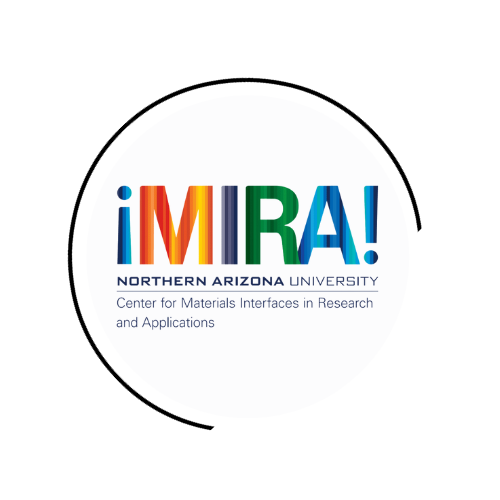Facilities
NAU materials synthesis and characterization

Faculty in ¡MIRA! have access to state-of-the art laboratory space for materials synthesis, including chemical synthesis as well as mammalian and bacterial cell culture laboratories. Among the equipment enabling materials synthesis are dynamic physical vapor deposition, Varian 3117 Thermal Evaporator for depositing polymeric thin films, a Lindberg HB 200 -1200 ºC muffle furnace, a high temperature furnace (2000 oC), a Micronanotools Spin Coater, Flexiwave Milestone Microwave synthesis system with 5 preparation vessels, a high performance Ball Milling instrument, Pelco CPD-2 critical point dryer, Emitech K750 freeze dryer, Denton Vacuum Desk II cold sputter etch unit with carbon evaporation accessory, a supercritical fluid extraction system, and King Fisher high throughput magnetic bead manipulation.
Analysis of materials is enabled by mass spectrometry (Bruker Microflex MALDI-TOF, Bruker maXis Impact EIS, Varian Saturn GC-MS, Varian 1200 LC-MS), ion chromatography (Dionex DX-100), and dynamic light scattering (Malvern NanoZetasizer). Electron microscopy includes Ziess Supra 40VP SEM, JEOL JSM-6480LV SEM, and JEOL JEM 1200-EXII TEM. Force and probe microscopy using Agilent AFM 5400 AFM/SPM, Agilent 5500 ILM AFM/SPM on an inverted light microscope, Asylum MFP-3D-BIO SPM with simultaneous scanning probe and optical microscopy, and Asylum MFP-3D are supported by in-house cantilever design capabilities. Light (Leitz Aristoplan Variophot, Zeiss Discovery V8 stereo microscope, Zeiss Axio Scope, Keyence VHX-2000 digital microscope, Leica DMIRE2 spinning disk confocal microscope) and fluorescence microscopy (Leica TCS SPE II confocal microscope, Zeiss Axiophot) facilities are enhanced by specialized capabilities in Raman (Xplora Horiba Raman Spectroscope with three laser lines) and Brillouin scattering spectrometry, as well as optical holography.
Additional analysis can be carried out via nuclear magnetic resonance spectrometry (Varian Mercury 400 and 500 MHz instruments), atomic absorption spectrophotometry (Perkin-Elmer Analyst 600 Atomic Absorption Spectrophotometer with graphite furnace, Perkin-Elmer Analyst 100 Atomic Absorption Spectrophotometer (Flame AA)), infrared spectrometry (Thermo-Nicolet Nexus 670 with ATR; Nicolet Avatar 360 with ATR; Varian 3100; Bruker Alpha with ATR), and UV/Vis spectrometry (Cary 60).
Electrochemical analysis capabilities include a Princeton Applied Research PARSTAT-4000, a Gamry 1000-E, and Admiral Instruments Squidstat Plus and Squidstat Penta potentiostat/galvanostats; all are compatible with three available Ametek sample holders for solid or liquid specimens. Mechanical characterization can be carried out on an Instron 8874 multi-axial test rig equipped with a biaxial load cell (±1kN axial & ±25Nm torsional); Instron 8802 multi-axial test rig equipped with a biaxial load cell (±250kN axial & ±100kNm torsional), and an Advanced Video Extensometer (AVE); and TA Instruments Discovery HR-2 Rheometer with tension testing – ETC heater. Thermal analysis equipment includes TA Instruments DSC-250 Differential Scanning Calorimeter and TGA-550 Thermogravimetric Analyzer.
¡MIRA!’s expertise in computer modeling is facilitated by tools such as COSMOL Multiphysics finite element solver, Inverse Quantum Engineering design tool, simulation tools for light-matter interactions, and the AMBER molecular dynamics simulation tool. NAU maintains a high-performance computing cluster (Monsoon) for use by the NAU community and collaborators with an estimated peak performance of 20 teraflops. Monsoon is comprised of 856 Intel Xeon cores, 12 TB of memory, and 4 Nvidia Tesla K80 gpu cores, with FDR InfiniBand interconnects, and 750 TB of shared storage.

